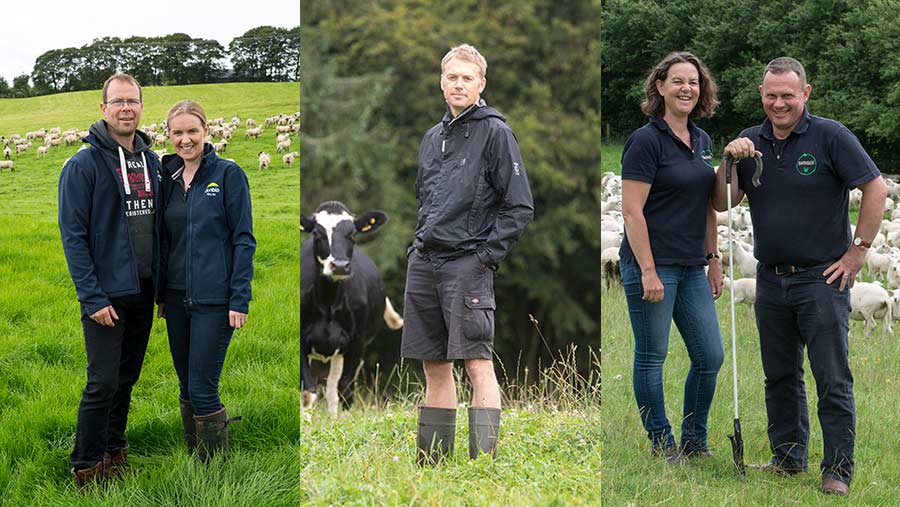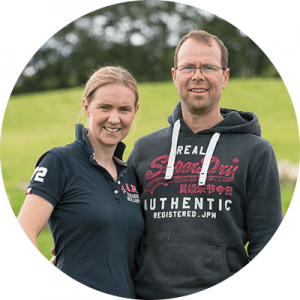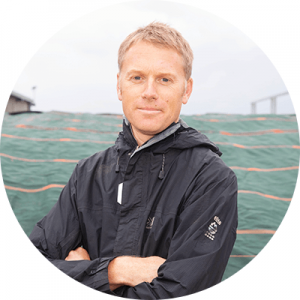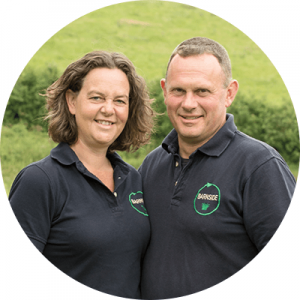Farmers Weekly Awards: Grassland Manager finalists 2019

All three finalists were focusing on growing quality grass and forage to reduce their reliance on bought-in feed and were shining examples of how farms can be productive while enhancing the environment by protecting watercourses and creating wildlife habitats.
See also: Meet the 2019 Farmers Weekly Awards finalists
The 2019 Grassland Manager of the Year finalists:
• Roger and Hilary Bell, Springmount Farm, Kells, Ballymena
• Dan Burdett, Cockhaise Farm, Haywards Heath, West Sussex
• Charley and Andrea Walker, Barnside Farm, Duns, Scottish Borders
The judges:
• Gareth Davies, independent judge and grassland consulltant
• Rhian Price, Farmers Weekly livestock editor
Roger and Hilary Bell
Springmount Farm, Kells, Ballymena
Roger and Hilary Bell are testament to what can be achieved with sheer hard work and tenacity.
They are growing an impressive 10.2t/ha from their grazing platform in a severely disadvantaged area (SDA).
Having inherited his 24ha home farm, Roger has worked off-farm contract shearing to help buy another 44ha to take their total land owned up to 68ha.
They have reclaimed land – draining, reseeding, planting 2,000m of hedges and building a circuit of stone lanes to make moving stock between fields easy. The result: their farmland is a patchwork of green oasis.
With Roger now running a contracting business, Hilary is at the helm of the sheep enterprise and she runs a sharp ship.
Their 543 Texel-cross Mules lamb indoors over six weeks from March to coincide with holidays for vet students. Ewes scan at 200% and ewe lambs at 150%; and they sell 1.79 lambs a ewe on average.
Ewes are housed in December and they are fed a total mixed ration comprising silage, by-pass soya and fats.
Forage
After lambing, ewes and lambs are rotationally grazed. Currently, they are taking part in an Afbi (Agri-Food and Biosciences Institute) Grass Project to determine whether eight-paddock or four-paddock systems work best.
The flock is split into two mobs of ewes and lambs. Grass covers are measured weekly with a plate meter, with grass data recorded on AgriNet. Grass samples are taken every two weeks and lambs weighed every two weeks.
After weaning, usually in July, tups and ewe lambs are separated and graze silage aftermaths, where Roger says they really “motor”. In 2018, lambs achieved daily liveweight gains of 317g from birth to weaning, and their average weaning weight was 33.7kg from grass alone.
In last year’s challenging growing season, the grazing platform grew 10.2t/ha – and, this year, they’ve already grown 6.5t/ha with no fertiliser, with nutrients only applied on a need-be basis.
Having the forage mentality of a dairy farmer – cutting early in May and taking up to three cuts annually – means they are making superb quality silage to feed throughout the winter.
In 2018, they grew 14.8t/ha from three cuts with first cut analysing at 39.7% dry matter, 16.2% protein and 12.2ME. Surplus silage is sold to bring in an additional £10,000.
Data driven
Every ounce of information is scrupulously recorded from weekly grass growth and fortnightly lamb weights to nutrient applications on a field-by-field basis. This informs every decision they make.
Soils are sampled annually with a Hilary documenting the results of pH, phosphorus and potassium, as well as growth data in a book. The worst-performing field is then reseeded each year. Currently, 96% of soils are pH 6 or above.
Finished lambs are supplied to the Co-op through Dunbia. Although the flock is EID-recorded, the abattoir is unable to report killing out data on an individual lamb basis. To overcome this, they number each lamb before they go to slaughter, so they can link performance back to tups and evaluate which breeds are outperforming others.
In 2018, they achieved 22kg deadweight at R2-3 on average. Singles reached slaughter by 172 days at 49kg liveweight. Twins required six days longer but were 0.5kg heavier.
“If it’s R3, I’m perfectly happy. I’m worse off chasing an extra 10p. I’m looking for a lamb that can do it off grass,” says Hilary.
Roger is constantly looking to drive efficiencies and innovate. He’s worked closely with Ritchey to design a bespoke weigh crate capable of electronically weighing 19 lambs per minute with one labour unit. He has also designed and engineered a platform for automatically weighing pet lambs.
Future
In one year’s time, they will be debt-free, but they don’t intend on standing still and are always looking to make improvements.
The ground is too heavy and wet for suckler cows at Springmount Farm, so the decision has been made to phase them out.
Going forward, they are considering closing their flock to maintain their high-health status and are trialling different grass varieties for finishing lambs.
What the judges say
Roger and Hilary make a formidable team. Together they have transformed their severely disadvantaged farmland into highly productive grassland for their sheep enterprise and have worked hard to build the business and pay off debt quickly.
Summary
The judges liked…
• Exceptional attention to detail
• Phenomenal use of data allowing them to scrutinise every aspect of their business
• Innovative – linking up with companies to develop bespoke technology
• Excellent quality silage and clamp management
• Great team, with each one bringing different strengths to the business
Farm facts
• 68ha owned and 12ha rented
• 750ft above sea level
• 1m of rain a year
• Heavy, peaty soils
• 543 Texel-cross Mule flock
• Keeping 120 ewe lamb replacements
• Buy in Scottish Mule replacements
• Lamb indoors over six weeks
• Rotationally graze
The numbers
• 140kg of concentrate fed per hectare in 2018-19
• £1093/ha output in 2018
• 320kg liveweight output/ha since 2011-12
• 10.2t/ha of grass grown on the grazing platform in 2018
• 25 ewes/ha on the grazing platform
• 7 ewes/ha across the whole farm
Dan Burdett

Cockhaise Farm, Haywards Heath, West Sussex
It takes courage to challenge convention, but Dan Burdett is doing just that by pioneering multi-species leys and grazing techniques on his organic dairy farm.
The low-cost, autumn calving unit has been under organic stewardship for 20 years, but productivity began to decline about five years ago, encouraging Dan to look for solutions.
“Our grass production was going down. We were in that 8-12-year dip.”
Losing a further 161ha of ground was another catalyst for change, explains the third-generation farmer. While many farmers would have seen it as gigantic backstep, Dan saw it as an opportunity to focus on the dairy business.
Grassland
While the farm hasn’t wavered in its belief of running a low-input system, since returning home seven years ago Dan has reinvigorated the enterprise.
His tonic to low grass output has been to use herbal leys comprising birdsfoot trefoil, alsike, chicory, plantain, cocksfoot and Timothy, alongside high-sugar grasses to restore soil health. The deeper-rooting varieties are also having the added benefit of maintaining growth when the farm burns off in the summer.
The result is a spectacular sight of biodiversity, with plants attracting an array of wildlife. Soil health has also reaped the rewards, and productivity has more than doubled from 5t/DM/ha grown in 2014, to 12.6t/DM/ha grown last year.
Cows are turned out early in January by on-off grazing. To overcome the challenge of having a slower start to the grazing season and allowing clover to take off in warmer temperatures, he has lengthened the first grazing round to 90 days.
At drying off, in July, cows mob graze standing hay with much of the grass trampled in, which provides food for the soil.
Providing quality forage is central to their autumn calving system and, at housing, cows are wintered on self-feed silage.
Soils and reseeding
Soils are sampled every three to five years, but the real testament to soil health is the regular digging of holes to reveal an abundance of worms.
The grazing platform is reseeded based on grass growth results with the worst-performing ley receiving a four-year herbal mix.
Silage ground is reseeded every four years using barley or forage rye as a breakcrop. Being organic, they can’t apply fertiliser, so dirty water is applied to the grazing platform using a Briggs irrigator from January to May, following the cows, and manure is composted for 12 months before spreading.
Dan and herdsman Luke have tightened up their calving block from 15 weeks, starting from August, to just six weeks by selling cows that fell out of their block, and lifting their replacement rate to 30%. This has been no easy feat with the herd size increasing at the same time from 240 to 300 cows, but they are now in the position where they are able to sell surplus heifers to add value to the milk cheque. Beef calves are sold through an integrated supply chain. This is bolstered by excellent herd health.
He’s a great advocate for sustainable farming methods, having planted 600m of hedgerows and planted trees to provide wildlife habitats. Dan is also working with South East Water and local river trusts to reduce pollution.
Future
Dan aims to reduce bought in concentrate fed to 1.2t a cow, and is growing Lucerne this year to help achieve this.
A contract farming agreement was set up six years ago with Dan’s father and aunt, who own the farm. He provides the labour, machinery and cows and, in return, receives a fee and profit share.
“It’s been a good way of transferring ownership of the herd. It definitely gives you the edge.”
Dan sees huge potential for rolling this business model out and taking on other farms. But he remains firm in his belief that profitability cannot be to the detriment of the environment.
“Our overall goal is to prove we can farm productivity and environmentally.”
This is a message he’s keen to convey to the general public through his social media accounts and hosting Open Farm Sunday, which regularly attracts 800 visitors.
What the judges say
Dan is constantly looking at how he can improve the efficiency of his 300-cow organic dairy and future-proof his business against volatility by growing quality grass, high in protein.
Summary
The judges liked…
• Highly profitable business
• Clear direction for the future
• Not afraid to try new things
• Voluntarily working with organisations to improve environmental management
• Strong interaction with the public to promote farming
Farm facts
• 280ha (part owned and part rented)
• Business run as a contract farming agreement
• 300 autumn-calving cows
• Sells organic milk to Arla
• Milking twice daily
• Produces 6,200 litres of milk
• Employs two full-time staff
• Rearing heifers off-farm from age six months to 18 months
• Receive 600ml rainfall annually
• Soils ranging from weald clay to Tunbridge Wells sand
The numbers
• 3.97cows/ha on the grazing platform
• 1.4t concentrate fed annually
• 6 weeks calving period
• 12t DM/ha of grass grown on the grazing platform
• 10-12ppl comparable Farm Profit
• 3,212 litres of milk from forage
• 475kg milk solids produced per cow
• 79% conception rate after three weeks
• 6.5 cases of mastitis annually
• 94% of herd receiving no antibiotic tubes at drying off
Charley and Andrea Walker

Barnside Farm, Duns, Scottish Borders
The Walkers are champions for sustainable red meat production in the uplands.
By running an all grass and forage system and outwintering stock on deferred grass, they have built a resilient, low-cost, organic beef and sheep system that isn’t reliant on bought-in protein.
The couple don’t carry any passengers – an attitude they adopted from working on farms in New Zealand.
Any animal that requires treatment or with bad temperament goes into a B mob and won’t breed replacements.
Good fertility is the linchpin to their low-input system, with Welsh Black cross Angus cows calving in just six weeks from April. Easycare ewes are bred pure and lamb for three weeks from mid-April. Barren rates are low at just 8% for cows and heifers after two services, and 5% for ewes and ewe lambs – and assistance is rare.
“Because we are doing everything ourselves, we identified quite early on that the way to manage things well was to have compact lambing and calving,” explains Charley.
Grassland
Calving and lambing in the spring means they are able to best match demand to their growth curve.
They run four grazing blocks and operate a clean grazing policy, alternating between cattle and sheep on each to reduce worm burdens, with FECs taken every two weeks.
Ewes and lambs are rotationally grazed and complete three 24-day rotations up to weaning in early August with lambs achieving daily liveweight gains of 250-275g. Post-weaning lambs move on to red clover silage aftermaths for finishing, and ewes clear up behind them with the thinner ewes receiving the first bite.
Farmax is used for forage budgeting to identify pinches in their system. This proved indispensable last year when the drought bit, allowing them to reduce stock numbers by getting rid of empty ewes and steers sooner.
Stock are outwintered on deferred grass on a “sacrifice” paddock earmarked for reseeding from a block of six silage fields. This allows muck to be applied before the field is reseeded with ryegrass and clover to improve soil fertility. Stock is supplemented with quality baled silage from November and December, with woods providing shelter against adverse winter weather conditions.
Herbal leys are grown on the grazing platform and, on south-facing land, deeper-rooting varieties, such as cocksfoot, is used for drought resistance.
Co-operation
The Walkers are working closely with other farmers to add value to their produce.
Two years ago, they set up a joint venture with fellow organic farmer Giles Henry, from Selkirk, which involves sending steers to his farm for finishing.
They retain a half share and pay half for grass keep. The proceeds are shared once the cattle are sold to Dovecote Park, where they receive a premium through the organic native beef scheme.
Store lambs are sent to a local organic farmer for finishing on red clover grown as breakcrop, and they winter graze ewe lambs at another organic unit.
This has allowed them to lift stocking rates and build up grass covers for winter.
Environment
Charley and Andrea are already showcasing the benefits that beef can offer to the environment by planting 3km of hedgerows to create a network of wildlife corridors bustling with birds. Hedges are only cut every three years and they have fenced off wetter areas of the farm for wading birds, and dug shallow ponds to create habitats for feeding chicks. River ground has also been fenced off to prevent water contamination.
Charley’s future goal is to challenge the negative press suffered by the red meat industry about carbon and methane pollution.
In an attempt to do this, they are trialling holistic grazing for the first time this year on one of the blocks. This involves mob grazing cattle at higher entry and exit covers, to help build organic matter in the soil.
As well as weighing animals, they will take soil samples and measure carbon sequestration. If it shows good results, they will holistically graze all cattle going forward.
“I want to enjoy farming and leave a legacy, not necessarily for my kids, but to leave the land better than we found it to whoever comes along next.”
What the judges say
Andrea and Charley are proof that efficient and profitable red meat production can go hand in hand with environmental practices. They are running a self-reliant grass system fit for the future.
Summary
The judges liked…
• Exceptional flock and herd fertility
• Strong cooperation with other farmers
• Focus on simplicity to reduce workload
• Truly self-sustainable system, not having to buy in feed
• Provides habitats on the farm where wildlife can thrive
Farm facts
• 254ha tenanted farm
• 640 wool shedding ewes
• 110 Welsh Black cross Angus cows
• Switched to organic in 2006
• Selling beef to Dovecote Park
• Prime sheep marketed through the Scotch Country Lamb co-op
• 40ha in environmental stewardship and another 20ha of heather moorland
• 800m above sea level
• 30in rainfall annually
The numbers
• 280kg/ha average livestock weight produced in 2012-18
• £762/ha total output over the past three years
• 45% increase in output since switching to rotational grazing in 2014
• 7.5t dm/ha of grass grown across the farm (excluding stewardship ground) in 2018
• £1.43/kg production cost of liveweight beef in 2017
• £1.36/kg production cost of liveweight lamb in 2017
• 0.97 livestock unit on the whole farm
• 67kg/ha concentrate fed per hectare in 2018
Sponsor Germinal

“Success in grassland management requires a broad skill set. By putting a spotlight on leading farmers and celebrating their success, Germinal aims to raise standards and ensure greater understanding and utilisation of the best available home-grown feed.”
Paul Billings, managing director, Germinal GB
